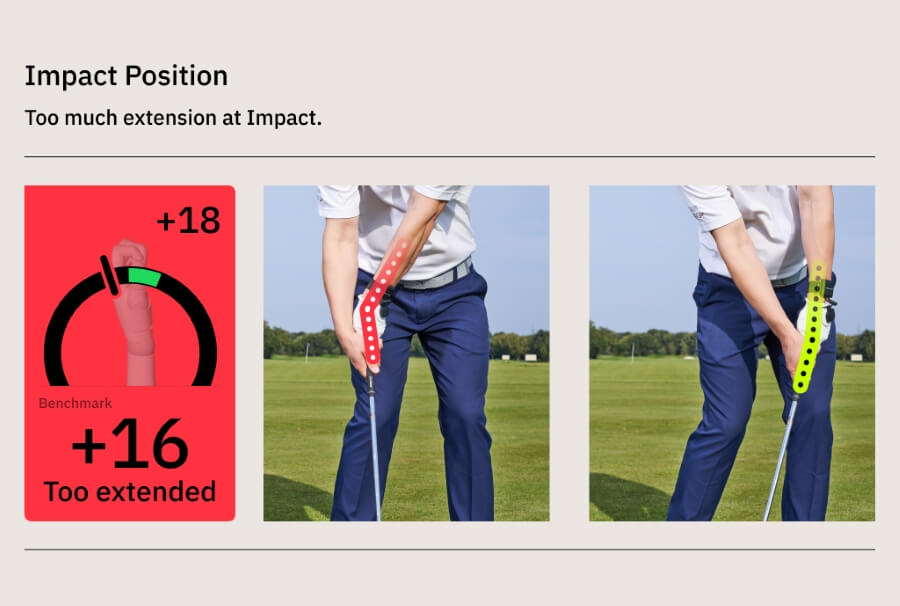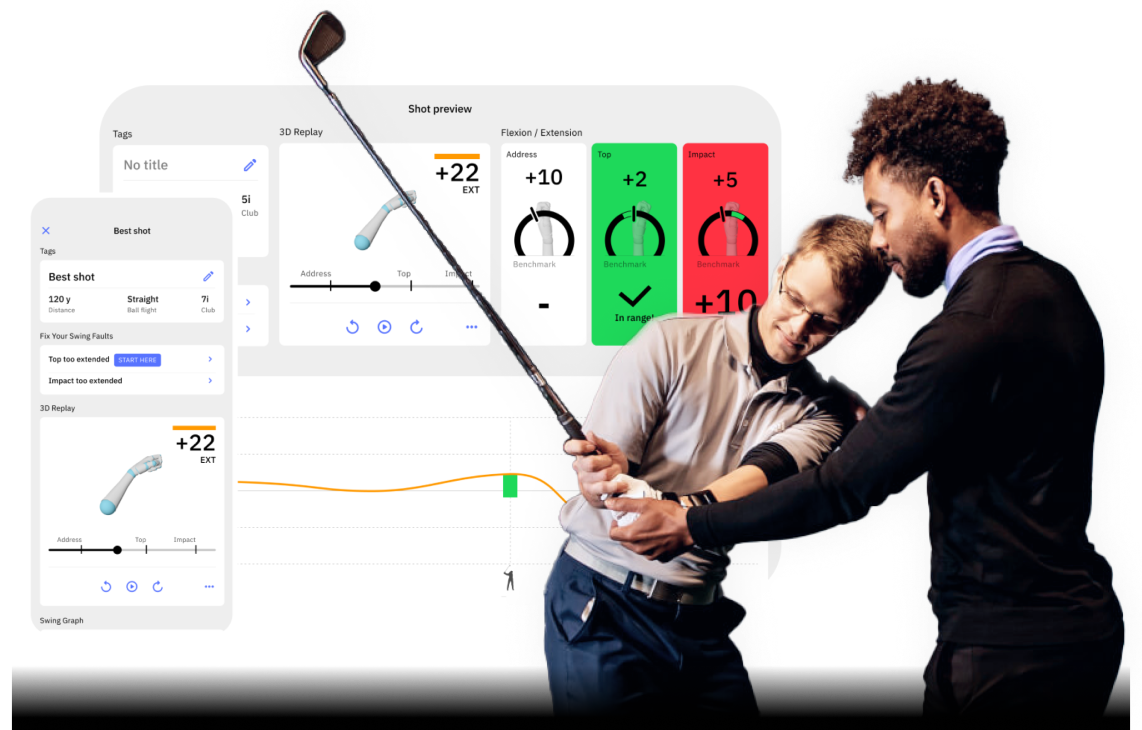Track Golf Stats: Key Metrics That Will Help Lower Your Handicap
Without proper golf stat tracking, it’s nearly impossible to know where your golf game needs improvement. Tracking golf stats is easier now than it ever has been with the use of modern technology.
This guide teaches you how to track golf stats and which metrics are essential to keep an eye on.
After reading this guide, you will know what to track, how to monitor it, and why it helps in your quest to improve your golf swing.
Golf Stats to Track Progress (Key Takeaways)
If you don’t have time to read our entire guide here are the most important takeaways about tracking golf stats.
- The basic stats of greens in regulations, fairways hit and number of putts are easy to track with a golf app.
- You should also be tracking things like wrist control and angles through the golf ball if you are trying to make big changes in your game.
- Strokes gained is a more advanced stat and will help you choose the best way to practice on the driving range.
- Don’t forget about tracking your scrambling percentages.
Contents
What Golf Stats are Worth Tracking?
Beginner golfers can start to make some progress in their golf game and really understand what makes them the player they are when they start to track their stats.
Golf stats that beginners should track will be a little different than those that professionals track because they don’t need to be quite as detailed at this stage.
Fairways Hit
Getting the ball in the fairway means hitting more greens in regulation and scoring lower.
On a standard par 72 golf course, you find 14 fairways per round because your tee shot on par 3’s does not have a fairway.
Hitting an approach shot with a 7-iron out of the rough is markedly different from hitting one with a 7-iron on the fairway. Shots from the fairway have an easier time spinning on the green, so you can stop the ball much easier.
Take a look at which clubs used off the tee give you the highest fairway hit percentage. For instance, I know I can hit the fairway with my 5 wood almost every time, where the driver has a slightly higher dispersion rate. This is good information when you need to hit a fairway.
Greens in Regulation (GIR)
Unlike fairways hit, where there are only 14 fairways to hit, there are 18 greens to hit in regulation, so you have your work cut out for you here.
A green in regulation is:
- Hitting the green in one shot on a par 3
- Hitting the green in two shots on a par 4
- Hitting the green in three shots on a par 5
It’s very hard to hit every green in regulation; it’s not something that happens on a consistent basis. Even professionals struggle with this. Akshay Bhatia achieved this feat at Pebble Beach in 2021, a rare occurrence for seasoned professionals.
Golf Magazine suggests that 15-handicap golfers hit 26% of greens in regulation in a round, while 20-handicappers are down at 20%.
As we descend the handicap ranks, we find 25-plus handicappers only reach 16% of their greens in regulation.
The more greens you hit in regulation, the more two-putt pars you enjoy, which is less stressful than chipping to get up and down.
The easiest way to hit more greens in regulation is to control the clubface. This can be done using the HackMotion wrist sensor. You’ll want a flat lead wrist at the top and a flat or slightly flexed wrist at impact.

Scrambling
No day on the golf course is perfect; you are always going to run into some kind of trouble. Scrambling is how you fix this trouble.
Scrambling refers to a golfer who missed the green on approach, chipped on, and put the ball in. It is also referred to as an up and down.
Using the 15 handicap example above, we notice they hit 26% of their greens, equating to approximately 5 per round.
Therefore, you are left to scramble to get up and down for par on 13 holes. If your ball ends far from the cup and you miss the putt, it is an unsuccessful scramble.
Every time you cannot get up and down, you lose a stroke
As a result, you lose on average, about 10 strokes per round. If your net score after 18 holes is 103, you will realize how much a weak scrambling game costs you. For some players, this is the key to breaking 100, 90, 80, etc.
Putts Per Round
Once on the green, it is time to track your putts per hole and total putts for the round.
Like scrambling, it is another area where amateur golfers leak strokes and miss out on breaking a milestone score.
A Golf Digest article suggests the average golfer records 34 putts per round.
However, we have to remember how many greens the average golfer misses. If you miss those greens, chip on, and two putt, the number of strokes is really starting to add up.
The fewer putts you card per round, the quicker strokes are shaved from your score.
If a player shoots 90 on average and strokes 34 putts, they hit 37% of their shots with a putter.
The quantity of shots hit with a putter explains why it is an integral part of your game, which helps you transform your game, net scores, and handicap.
I recommend getting a better idea of where your putting game is struggling by recording the distances of the putts you miss.
The HackMotion can be worn on your wrist as a putting feedback tool. It helps to record the consistency of your putting stroke so you know that it doesn’t change much from round to round.
Record data about your putting stroke and mostly look at how inconsistent it is from one stroke to the next. If you are not keeping your wrist motion constant, the club head is returning to the ball in a different way each time.
Penalties
Track your penalties, but most importantly, learn proper golf course management. This will help you ensure that you are not racking up too many penalties.
Finally, familiarize yourself with the rules of golf to reduce your susceptibility to silly violations that cost you a stroke or two.
Total Score
Finally, track your total score with a handicap tracking system. Watching your handicap decrease over time is a very powerful way to track your golf progress.
Set yourself long-term milestones to work towards, like breaking 100, 90, or 80. Then use the provided statistics above to identify crucial areas of improvement and strong points in your game.
In addition, look at which nine you were stronger. A shaky front nine may stem from an unsatisfactory warm-up, unfavorable weather conditions, or a layout not ideal for your shot shape.
Advanced Stats to Measure Golf Progress
After you have become an expert at tracking the basic golf stats, you can now start to get into the more advanced.
With more advanced stats in golf, you can pinpoint the exact areas of your game that need your attention.
Misses
Start keeping track of all of your misses. Are you hitting the ball thin, fat, left, right, etc?
The key is to pay attention to the misses that are costing you the most strokes. You’ll start to realize if this is a random issue or if you have something in your game that needs adjustment.
Based on what your misses are, take a look at our driving range practice plan quiz and set something up that works specifically for your game.
Proximity to the Hole
Proximity to the hole determines how close your ball finishes to the cup on approach.
Naturally, the nearer your ball is, the higher your chances of making the putt.
In addition, players stand a higher chance of making uphill putts, as the speed is less demanding to judge than downhill putts.
Sand Save Percentage
First, make yourself the goal of getting out of the bunker in just one shot. As you get better, you can work on getting it closer to the hole.
Think about changing up your golf wedge from time to time. Sometimes it’s good to use a gap wedge or lob wedge to vary the distance.
Lob wedges are a perfect club for a short up and down from a short-sided greenside bunker.
Club Distances
Another stat to track requires a distance-measuring device for precise reads.
A rangefinder or a golf GPS device can help you decipher the average yardage of each golf club in your bag. The better you understand how far you hit each club, the easier it is to make correct selections.
Pay close attention to carry distance. Total distance is how far the ball carries plus the total roll, but the most important yardage for you to know is carry distance. Keep a detailed record of how far you hit each golf club.
Wrist Angles and Club Path
Experienced golfers track intricate details of their swing, including wrist angles, club path, and angle of attack.
Wrist angle stats enable golfers to identify why their clubhead speed is dropping, or the clubface is opening at impact and causing a slice.
The best way to monitor wrist angles is the use of the HackMotion sensor. The HackMotion will monitor your wrist angle at setup, at the top of your backswing, and at impact.
We know after analyzing and tracking more than 1,000,000 golf swings that there are certain wrist angles that all golfers should aim for in their swing.
One of the most important parts of this is ensuring that your wrist is flat or even slightly flexed at impact.

How do I Monitor Golf Performance?
To monitor golf performance, you can use one of the following methods.
- Track on your phone with a stat tracking app.
- Use strokes gained app or calculator to monitor your performance.
- Write everything on the scorecard and use an Excel sheet after the round to plug your stats in.
- Digital Scorecard when playing a round of golf.
- Launch monitor analytics, save your sessions, and compare progress.
- HackMotion wrist sensor and practice session history.
FAQs
Should I track my golf shots?
Yes, you should track your golf shots to see where your game stands and if you are improving or struggling to progress. In addition, monitoring your strikes adds an element of competition to an individual sport as you see how your scores compare to your buddies.
What do you keep track of on a golf scorecard?
A golf card helps you keep track of your gross and net score for each hole, the front and back nine and 18 holes. You can also track things like the number of putts, fairways hit, etc.
Does tracking wrist angles help me improve my golf game?
Tracking your wrist angles can help you become a much better golfer. The most important thing to look for is controlling extension at the top of your swing and impact and creating a more consistent position with your wrist each time you swing.
Final Thoughts
Our guide on how to track golf stats highlights the importance of monitoring your performance to help you get better at golf.
Start with basic metrics like fairways and greens in regulation, total score, putts per round, and penalties. Then, graduate to advanced stats like sand saves, club distances, wrist angles, and club path.















